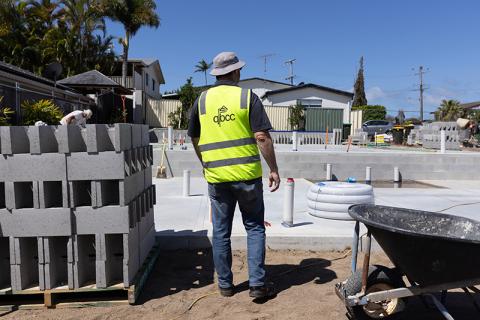For annual reporting purposes, the financial information is submitted on the trust as the trading entity, noting in the appropriate section that the licensee trades through a trust structure. When providing an MFR report, financial statements are required for both the trust and the trustee.
It is a requirement under the Corporations Act 2001 to keep financial records, and the QBCC doesn’t have the discretion to waiver this requirement for MFR reports. Even if the trustee entity only has paid up capital of $2, the balance sheet would show assets of $2 and the P&L would show $0 income.
Q&A
Can the myQBCC be used to submit an MFR report?
No, the online portal is only set up at this stage for annual reporting purposes. To lodge an MFR report, the information would need to be submitted either in person at a QBCC office, or via email to MFRQueries@qbcc.qld.gov.au
Why doesn’t QBCC accept goodwill that has been physically paid for via a business purchase?
When assessing financial information, the QBCC is bound by the legislation set out in the MFR Regulation. The regulation specifically excludes intangible assets from calculations, and the QBCC does not have the discretion to waiver this requirement.
Can SC1 or SC2 rely upon a deed of covenant and assurance?
Legislation as it currently stands does not allow a SC1 or SC2 licensee to rely on a deed, only financial categories 1 - 7.
For a SC1 entity to trade through a trust structure, the trustee entity would need to:
- be sufficiently capitalised, with an NTA of $12,000 (in its own right), potentially undermining the purpose of having a trust (if those assets are then held by the trustee)
- meet category 1 requirements and rely upon a deed, which means increases its NTA to a total of $46,001.
Unfortunately, the QBCC does not have any discretion in relation to this legislative requirement.
NTA of trust structures
The MFR Regulation outlines how trust assets are to be calculated.
The regulation defines a reference to:
- NTA as a reference to trust assets
- a licensee as a reference to the trustee of the trust.
The regulation specifically disallows items such as intangibles, contingent assets, debtors between 180 and 365 days or debtors over 365 days.
This means if the trust records one of these items as an asset, they must be disallowed. If the trust records borrowing costs or includes goodwill, these amounts need to be deducted.
If deducting disallowed or intangible asset amounts from the trust’s net asset position results in a negative NTA position for the trust, this negative NTA position would then flow back to the trustee (licensee) entity. The licensed entity (trustee) would then need sufficient NTA of its own to absorb any deficiency in the trust.
Asset write-off/PPE/Tax vs Accounting FS
Instant asset write-off occurs due to the tax treatment of assets. It should be noted that the depreciation and write-off treatment off assets under the Australian Accounting Standards differs from treatment for tax purposes.
The QBCC’s annual financial reporting obligations do accept internal management accounts being provided for SC1 and SC2 licensees and those in financial categories 1 - 3. This means we can accept the financials at book value (for annual reporting).
When providing financial information for other MFR obligations such as applying for a licence, or upgrading maximum revenue, the financial statements need to have all relevant accounting standards, which means the assets would likely be written down for tax depreciation purposes.
If applying accounting standards to revalue an item of property, plant or equipment, the correct accounting standard must apply (ie AASB 116 / AASB 136 / AASB 1041).
It should be noted, that if an item of property, plant and equipment is revalued, the entire class of property, plant and equipment to which that asset belongs needs to be revalued. These revalued amounts would then need to be included in the company’s financial statements, which should also reflect the increase in income as well as accumulated in equity under the heading of revaluation reserve.
Gifts
The QBCC accepts accounting treatments applicable under the Australian Accounting Standards. For assistance with applying these standards it is recommended you seek guidance from your professional accounting body.
It should be noted, during an MFR assessment, an amount gifted to the trust may require evidence of the gift (such as a copy of the deed of gifting).
Related entity loan assets
The NTA of a related entity must be calculated under normal MFR provisions. This means that all liability items must be included as liabilities of the related entity regardless of whether the liability is owing to a related party (such as the licensee).
Related entity asset loans can be included as an asset of the licensee if the related entity’s financial position meets the criteria set out in section 15(1)(l) of the MFR Regulation (the related entity needs to have a current ratio of not less than 1:1 and NTA of at least $0).
If the related entity asset loan is included in calculations for an MFR report, supporting evidence such as a balance sheet (for a related company) or statement of financial position (for a director) would be required to confirm that the related entity meets the criteria of section 15(1)(l).
If the related entity asset loan is not material to the licensee’s current ratio or NTA requirement, you can elect not to include the amount in calculations. However, related entity liability loans cannot be deducted under any circumstances.
Unpaid present entitlements
An unpaid present entitlement (UPE) is usually a current liability in the trust, unless the parties have entered into a legally binding agreement for its repayment, for example, a div 7A loan. This is because the trust does not have an unconditional right to defer settlement outside 12 months.
In the case of a UPE being recorded as a current asset, the QBCC would need information to confirm previous years’ trust distributions, including a copy of the resolution relating to the current years’ distributions or a copy of the beneficiary account (breakdown) from the ledger.
For UPE’s recorded as assets, the QBCC will treat these in the same way as related entity asset loans, requiring evidence that these amounts meet the MFR Regulation test by means of a balance sheet.
If a trust has a loss, how does that impact NTA?
If the loss in the trust causes the trust to have a negative NTA position, the deficiency of trust assets will be considered a liability for the trustee. This liability will be included in the licensee's calculations of NTA.
Licensee who trades through a trust later changes structure to trade in their own right
If a licensee, who is trustee of a trust, chooses to restructure their business to a standalone entity, they would be required to:
- notify the QBCC under section 11F of the MFR Regulation (significant change to business) and
- provide an MFR report demonstrating that the licensee continues to meet the MFR after the change.
The licensee will need to show that they are no longer operating through a trust, so they may choose to provide a deed of amendment or deed of vesting to do so.



